Dr. Utr. Iur.
Frank
Van den Broeke

To book an authorised guided tour with me: .... Click here
Wine & Dine: ... Click here
Where to buy your tickets ... ? Click here
Whoever enters the Sistine Chapel, raises his eyes to the vault, where the painted architectural structure of Michelangelo opens as by miracle to an open space, where he painted the creation. Very rarely they looking at the lower paintings on the south and north wall. This chapel was the public chapel for Pope Sixtus IV - della Rovere. Even today it is still used. Most famous of course for the Conclave, the election of the new pope. But also, every year, on the 10th of January the Holy Father is baptizing there. Could there be a more appropriate chapel? Probably not. Who is becoming member of the Catholic Church will stand in a tradition starting with Adam and Eve, over Abraham, Moses, David and the Son of God himself: Jesus. And that all in a chapel build on the size of the Temple of Jerusalem. Everybody knows that the Sistine Chapel is used for the election of the new Pope during the Conclave; but from the very beginning of its existence it was also used for some important services of the liturgical year. And the first step is the baptism. There is a profound link between the biblical scenes on the walls and the final work of Michelangelo. In this article, I concentrate me on the the cycles of Old and New Testament on the walls. Under Pope Sixtus IV, Baccio Pontelli and Giovannino de’ Dolci were the architects of the chapel. The architectural structure of the chapel reflects the dimensions of the first Temple of Jerusalem, as we can find back in the book of Numbers in the Old testament. But for the Pope Sixtus IV, from the family Della Rovere (the Oak) it would become the Celestial Jerusalem. He was employing a precisely conceived program to illustrate through the entire cycle the legitimacy of his papal authority, running from Moses, via Christ, to Peter, whose ultimate authority, conferred by Christ, finds its continuation in the Popes.
1.Reflexion on the works
2.Biblical description of the Old Testament painting
3.Biblical description of the New Testament painting
I invite you to visit the first pair of paintings: Moses leaving Egypt-Baptism of Christ
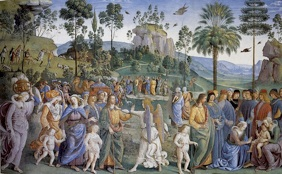
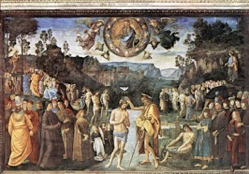
Walls of the Sistine Chapel, Introduction
The priorities of the Church changed over the history. As a consequence every new generation can find inspiration how the Church should be led.
-for Sixtus IV: approving of the legitimacy of Peter as successor of Christ
-for Julius II: the temporal power of the Church
-for Pope Francis: the charity of the Church
I like to describe the whole cycle of how we finding in the Law of the New Testament the fulfilling of the Law in the Old Testament.Each time I will put the two works next to each other and try to describe them in three steps: Every pair of frescoes creates a single article.
General introduction on the Sistine Chapel as it was before Michelangelo
The Cappella Magna (the main Chapel) of the Pope's Palace, was originally dedicated to the Assumption of the Vergin Mary. Perugino had the leading overview of the full cycle of old and new testament on the walls of the Sistine Chapel during the years 1481-5. For once, the single artists (who must have been rivals towards each other for obtaining commissions), had to work together. The whole offers an impressive unity. It looks almost like a modern cartoon: All the figures have the same size and even the colors are repeated. Moses will be always in green and gold, Jesus on the other hand, red and blue.Even if Perugino was the coordinator, it is for sure that only the strong power of Sixtus IV was able to bring those different characters together and creating theological unity.
And the names in the original contract of the artists were not the minor onces: Perugino, Botticelli, Ghirlandaio and Cosimo Rosselli. In the contract of October 27, 1481 is written: "depicting well, diligently and faithfully, the best they can ... (depingendum bene diligenter et fideliter melius quo poterunt (modo)".
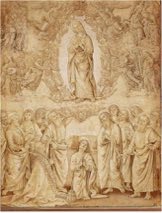
Anonymous Draughtsman, Copy of Perugino's lost Assumption of the Virgin on the altar wall of the Sistine Chapel, drawing, (Albertina, Wien)

Perugino,
Petro Christofori Castri Plebis Perusin
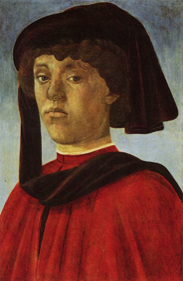
Sandro Botticelli

Domenico Ghirlandaio
Cosimo Rosselli
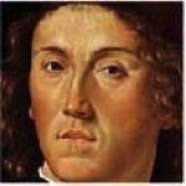

Piero di Cosimo

Luca Signorelli
In a second moment were added Luca Signorelli and Bartolomeo della Gatta and Piero di Cosimo and Biagio di Antonio
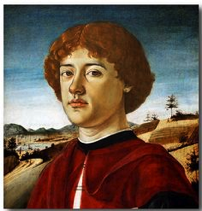
Portrait made by Biagio di Antonio
View also:
Together with Bartolomeo della Gatta
The Baptism of Jesus Pietro Perugino (Vanucci)
Moses Leaving Egypt Pietro Perugino (Vanucci)
The Biblia Pauperum was the way how in the medieval they connected old and new testament. Everything in the old testament was a profecy of the New. The Cycle in the Sistine Chapel is actually notting more than a modern version of it.
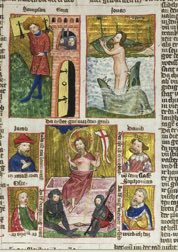
Biblia Pauperum